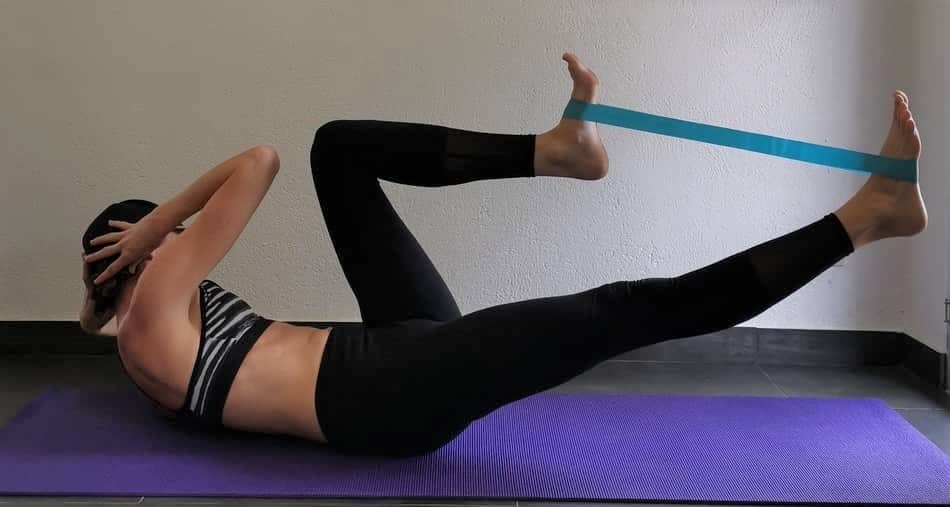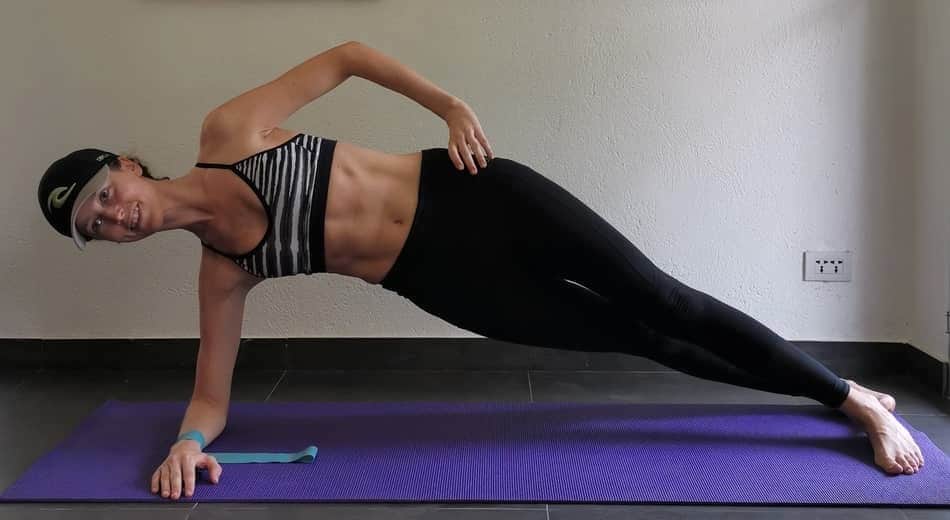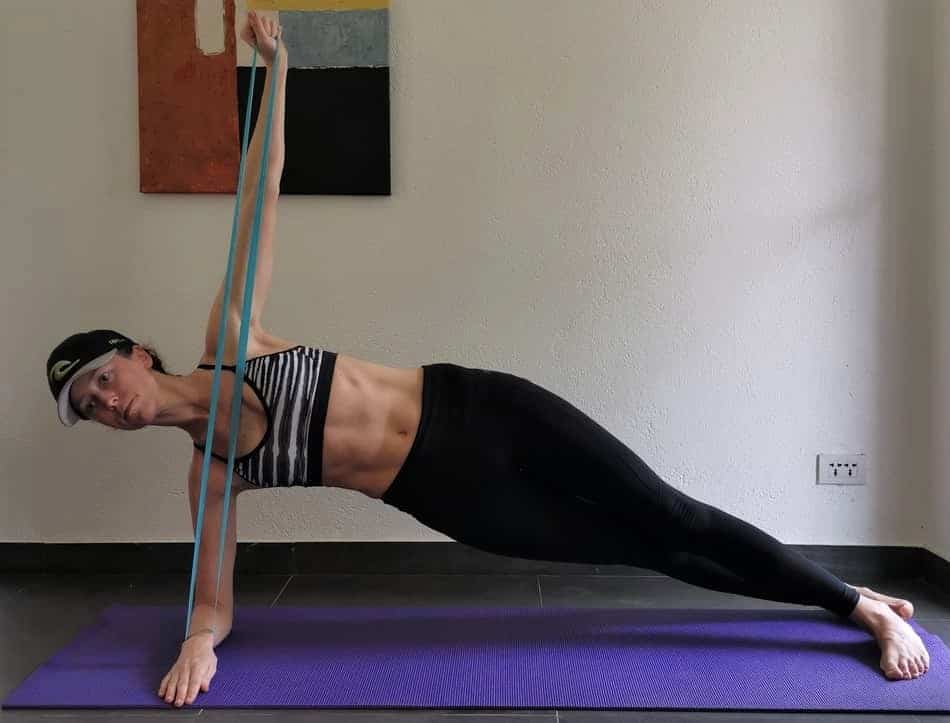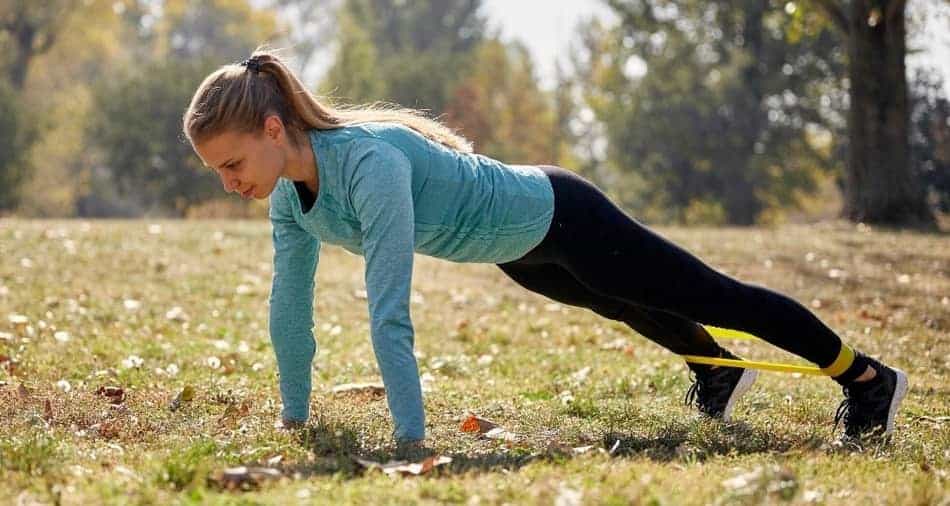
Resistance bands have become a staple in our luggage whenever we go anywhere for an extended period of time. It is such an easy tool to get more out of your workouts and take up no space at all. There are several types to choose from with or without handles, loops or straight bands. Whatever your preference is, we hope you will come to appreciate how practical these things are.
Psst! We also have resistance band workouts for LOWER BODY and UPPER BODY.
Why Core Strength is Important for Horse Riding
One of the ways you can quickly improve your horse riding skills and seat is by improving your balance. This will allow you to sit more comfortably on your horse, relax better and as a consequence, improve your overall posture. And what is the key ingredient in improving your riding balance? You guessed it – it is core strength.
What Core Muscles Does Horse Riding Work?
ALL. OF. THEM.
Your abs are just a small part of what we refer to as core muscles and are not even the most important. The core muscles extend from the chest to the pelvis at the front and from the middle back to the upper thigh at the back. Many of these muscles lie beneath the exterior muscles that you can see on a toned body, and their primary task is to stabilize and support the spine whenever we move.
Having a weak core means that a lot of strain is put on the spine, which can result in aches and pains and in the worst case, injury. Needless to say, equestrian spines are exposed to a lot of strain and pressure, so being able to support it through by having a strong core, is key to both the performance and prevention of injury.
Does Horse Riding Give You Abs?
Oh man, can horse riding give you abs! That said, just like for exercise in general, things like your body type, diet and fat percentage will determine whether your stomach will become visibly toned or not. However, if you ride regularly, I would be very surprised if you, over time, do not notice a difference in core and ab strength, which is what really matters.
What You Need for the Horse Learner Resistance Band Workout
- Resistance bands. We use loop bands for this article, but you can use any type of resistance band you have.
- Yoga mat. Any yoga mat you have available will do. You can also use a rug or towel if you don’t have a mat.
Check out the Follow-Along Workout on YouTube
Core Exercises
Core exercises is often about stabilization and activation of our mid-section and feels different from other types of movements because the areas we target often lie deeper than other muscles. Therefore it is key to focus on the area we are targeting and activating the core by ‘pulling the bellybutton in’.
Run through the exercises below three times each.
Exercise #1 – Bridge with Single Leg Extensions
Targets: Glutes, hip extensors and lower back.
Repetitions: 8 on each side
Place the band around your mid-thighs and lie on the floor with your knees bent and feet flat on the ground. Rest the arms along your side with palms facing down.
Lift your hips off the ground until the hips and shoulders form a straight line. Squeeze the glutes as hard as possible and keep your core engaged by sucking in the bellybutton so you don’t overextend your back.
While keeping your hips still and square, slowly straighten one leg so it is parallel to the other thigh. Bend the knee again and bring your foot back down to the mat. Repeat with the other leg. The core must be fully engaged when you extend the leg in order to prevent your hip from dipping down.

Lift the hips up 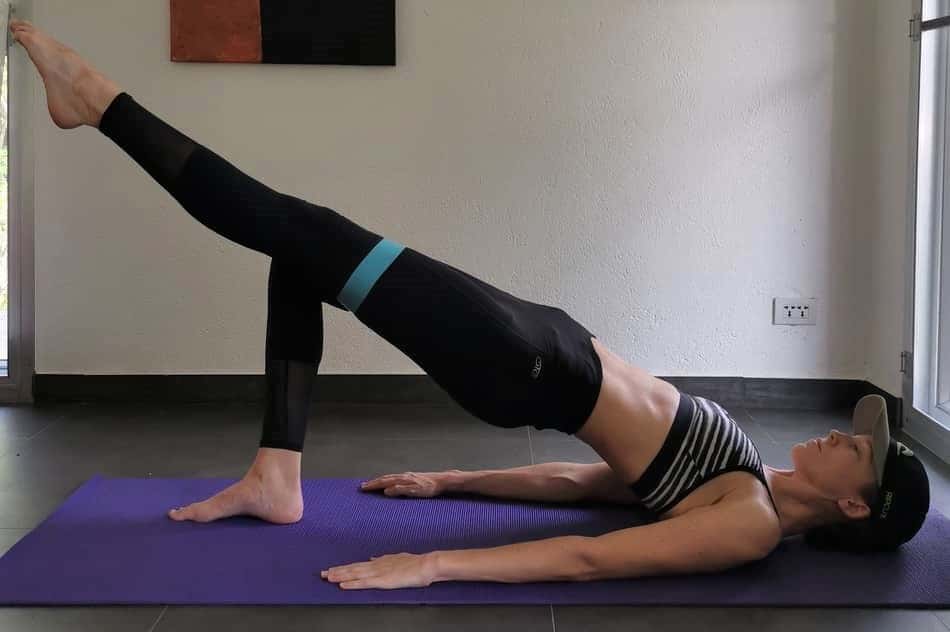
Stretch one leg out
Exercise #2 – Knee Drive to Elbow
Targets: Glutes, hip extensors, lower back and abs.
Repetitions: 8 on each side
Place the band around your feet and get into a plank position with your shoulders directly over your hands pushing them away from your ears. Keep your body in a straight line from the shoulders through the hips and down to the ankles. Your core should be engaged by sucking in your belly button and squeezing your glutes. Make sure your hips are aligned and don’t dip down (arching your back) or come up too high.
Keeping the torso still and hips square and level, bring the right knee towards the opposite elbow. Engage your core and bring it all the way if you can. With control, bring the leg back into the starting position and change sides. You can also do this exercise bringing the knee to the elbow on the same side, but with your knee pointing slightly outward.
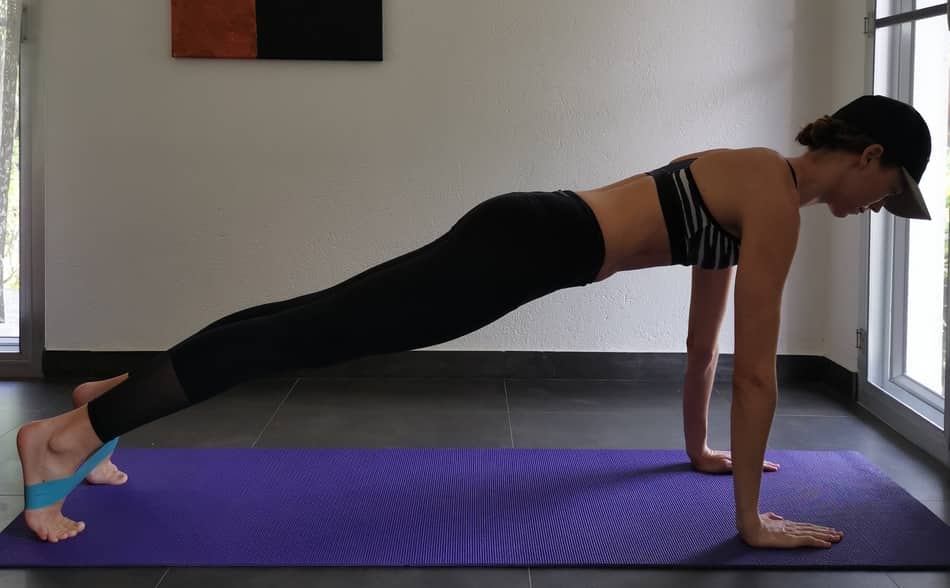
Plank position 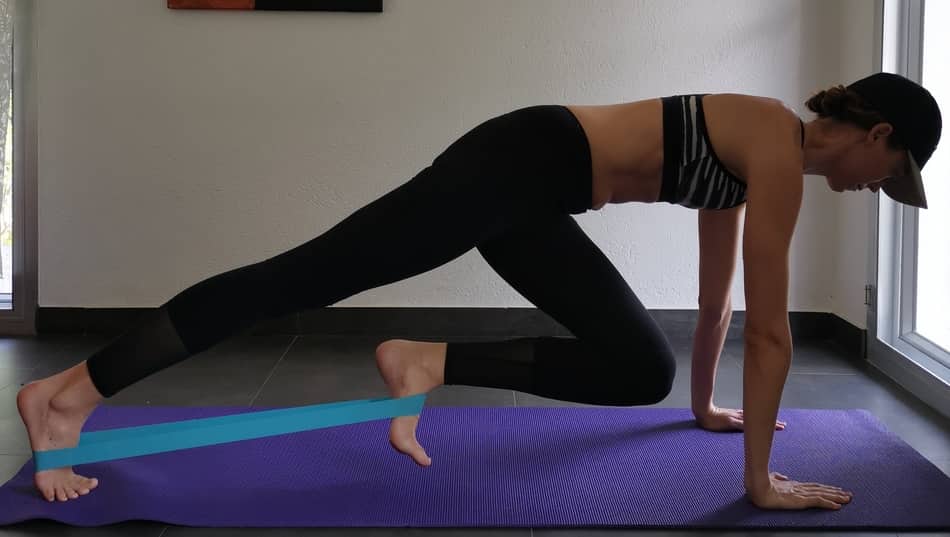
Pull knee to elbow
Exercise #3 – Plank Jumps Outs & Kickbacks
Targets: Glutes, hip extensors, hip abductors, hip adductors, abdominals, obliques
Repetitions: 8 jumps and 8 kickbacks on each side
Place the band around your ankles and start in a plank position with your hands directly under your shoulders pushing them away from your ears. Keep your body in a straight line from the shoulders through the hips and down to the ankles. Your feet should be hip-width apart and the core engaged by sucking in your belly button and squeezing the glutes. Make sure your hips are aligned and don’t dip down (arching your back) or come up too high.
Jump your feet to the outside of the mat and back in again keeping your core tight to protect your back from arching. When the feet come back in, extend one straight leg up and bring it back down with control. Lift the other leg and then jump again.
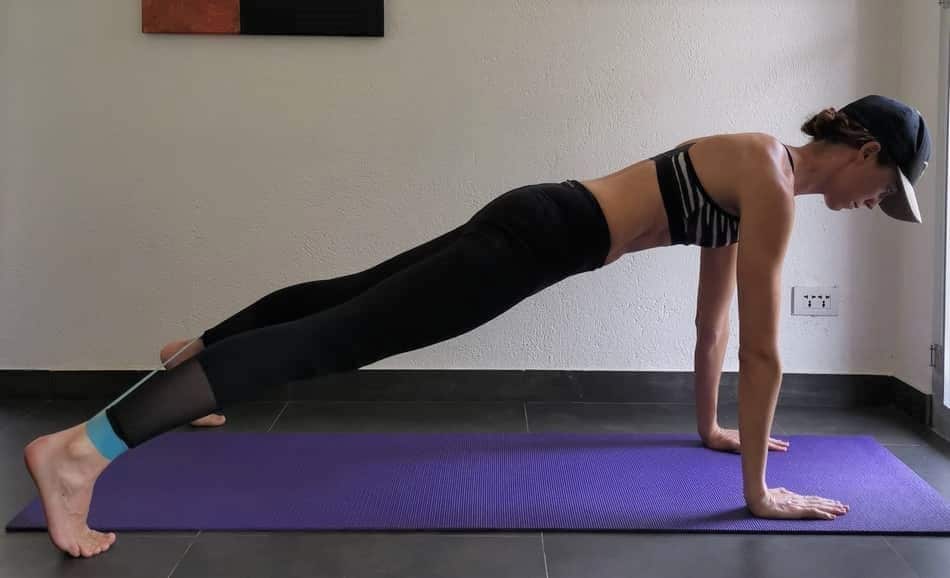
Jump out 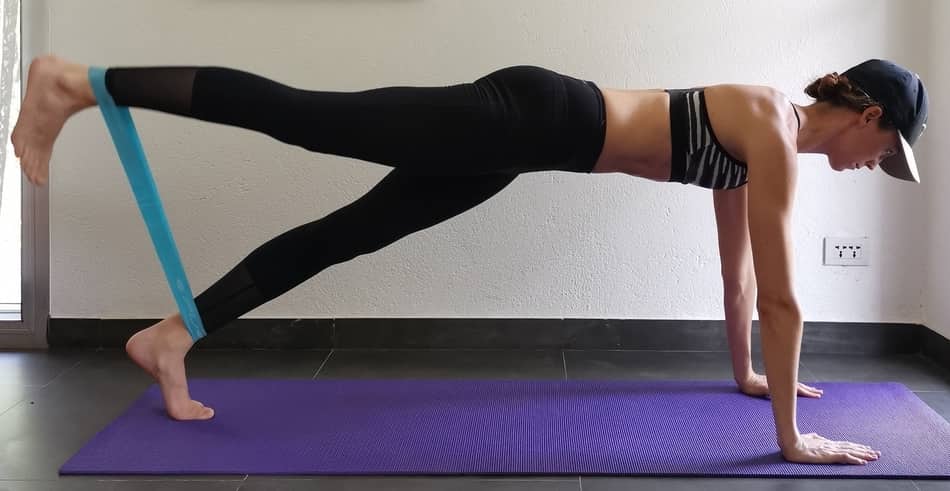
Leg raise
Exercise #4 – Bicycle Crunch
Targets: abdominals, obliques, hip flexors
Repetitions: 10 on each side
Lie down on your back on the mat, with your spine in neutral position and your legs in a 90-degree angle. Place the band around your feet. Put your hands behind your head (or ears) and lift your shoulder blades up from the mat by contracting your abdominal muscles while pulling your bellybutton in. Keep your elbows wide so you don’t pull on your neck.
Stretch one leg out at a time and bring the other in towards your chest. Bring your shoulder towards the opposite knee. Then switch so it becomes a smooth cycling motion. Make sure to keep your shoulder blades off the mat during the entire exercise. Move as fast but always with control and a stable torso. Try to avoid using momentum.
Exercise #5 – Side Plank with Arm Extensions
Targets: abdominals, obliques, hip flexor
Repetitions: 8 on each side
Get into a side plank with your elbow and forearm resting on the mat, your shoulder right over your elbow and your feet placed one in front of the other. Place the band around the forearm resting on the mat. Lift your hips as high as you can and try to keep them on top of each other, so you don’t tip forwards of backwards. Engage your core, pull your bellybutton in and squeeze your glutes to stabilize your torso.
Once in a stable position, grab the other end of the band with your free hand and start pulling the band straight up over your shoulder and bring it back down slowly. Your torso should remain still and your arm the only thing moving.
Exercise #6 – Superman with Arm Extensions
Targets: erector spinae (muscles supporting the spine), glutes, lower back
Repetitions: 8
Lying on your stomach on the mat, stretch your legs down and your arms overhead. Look down to the mat. Hold on to the ends of the band loop with your hands.
Lift both arms and legs up from the floor and pull the band slowly out and back in while still looking down to the mat. Lower your arms and legs and repeat.
What’s Next?
Make sure to vary which body parts you focus on for each workout. If you like this one, make sure to check out our Lower Body and Upper Body resistance band workouts too!
If you don’t have a resistance band – this 10-minute core workout does not require any equipment. If you like it, please subscribe!
This article is accurate and true to the best of the author’s knowledge. It is not meant to substitute diagnosis, prognosis, treatment or any type of professional medical advice. Use common sense when exercising and consult your physician before starting any new training program.
